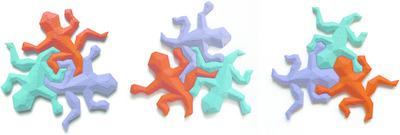当前位置:
X-MOL 学术
›
J. Appl. Crystallogr.
›
论文详情
Our official English website, www.x-mol.net, welcomes your
feedback! (Note: you will need to create a separate account there.)
Teaching periodicity and aperiodicity using 3D-printed tiles and polyhedra
Journal of Applied Crystallography ( IF 5.2 ) Pub Date : 2020-10-19 , DOI: 10.1107/s1600576720011772 Lluís Casas
Journal of Applied Crystallography ( IF 5.2 ) Pub Date : 2020-10-19 , DOI: 10.1107/s1600576720011772 Lluís Casas

|
Unit cell and periodicity are key concepts in crystallography and classically were thought to be inherent properties of ordered media like crystals. Aperiodic crystals (including quasicrystals) forced a change of paradigm, affecting the actual definition of a crystal. However, aperiodicity is usually not taught in crystallography undergraduate courses. The emergence of low-cost 3D-printing technologies makes it possible to tackle hands-on learning of the commonly taught crystallography concepts related to periodicity and to introduce in an uncomplicated manner aperiodic crystals and their related concepts that usually are skipped. In this paper, several examples of the use of 3D printing are shown, including 2D and 3D examples of periodic and aperiodic ordered media; these are particularly useful to understand both conventional periodic crystals and quasicrystals. The STL files of the presented models are made available with the paper.
中文翻译:

使用 3D 打印瓷砖和多面体教授周期性和非周期性
晶胞和周期性是晶体学中的关键概念,传统上被认为是晶体等有序介质的固有特性。非周期晶体(包括准晶体)迫使范式发生变化,从而影响晶体的实际定义。然而,晶体学本科课程通常不教授非周期性。低成本 3D 打印技术的出现使得人们可以解决与周期性相关的常见晶体学概念的实践学习,并以简单的方式引入通常被跳过的非周期性晶体及其相关概念。在本文中,展示了几个使用 3D 打印的示例,包括周期性和非周期性有序介质的 2D 和 3D 示例;这些对于理解常规周期晶体和准晶体特别有用。本文提供了所呈现模型的 STL 文件。
更新日期:2020-10-19
中文翻译:

使用 3D 打印瓷砖和多面体教授周期性和非周期性
晶胞和周期性是晶体学中的关键概念,传统上被认为是晶体等有序介质的固有特性。非周期晶体(包括准晶体)迫使范式发生变化,从而影响晶体的实际定义。然而,晶体学本科课程通常不教授非周期性。低成本 3D 打印技术的出现使得人们可以解决与周期性相关的常见晶体学概念的实践学习,并以简单的方式引入通常被跳过的非周期性晶体及其相关概念。在本文中,展示了几个使用 3D 打印的示例,包括周期性和非周期性有序介质的 2D 和 3D 示例;这些对于理解常规周期晶体和准晶体特别有用。本文提供了所呈现模型的 STL 文件。











































 京公网安备 11010802027423号
京公网安备 11010802027423号